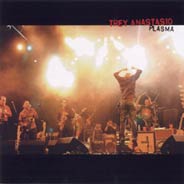
Trey
Anastasio
Plasma
(Elektra)
At
the time of its release, in April 2002, Trey Anastasio – the first solo album
by Phish guitarist to appear after the group went on hiatus – did not get
too much space in the music press. Nor a lot of people seemed to bother listening
with much attention, save for some of those critics who still deal with music
seriously (for instance, check the interview by Robert
Doerschuck which appeared in On Stage Magazine). Which in a way was not terribly
unexpected: Phish are mostly seen as mainly a cultural – not a musical – phenomenon,
and the Anastasio tour that was in the works was not expected to draw the
same oceanic audience as Phish.
Which is a pity, since the new line-up, with its drier rhythm section
and its large horn section, gave Anastasio the chance to change its musical
palette and to explore very different climates and timbres than in his past.
Anastasio has said that he intended to have a "dance band" where
the fun element didn’t necessarily negate a sophisticated dimension in the
musical language dept. The album was a grower (which nowadays can only signal
"commercial disaster"), and it sounded like a whole even in the
light of the many different elements it featured – say, latin rhythms and
Hendrix moves, melodic ballads and funky rhythms, plus some things I did not
expect (The Who?). As per Anastasio’s belief, things have to go on stage,
so it’s only logical that a double CD is now released to document last year’s
concerts and show the progress made.
Which Plasma accomplishes egregiously. Two hours long, recorded live
to two track – very clearly, but I found the sound to be a bit tiring when
I listened to the whole album in one sitting. The rhythm section (Markellis
and Lawton, plus Cyro Baptista on percussions) works fine, the horns (saxophones,
clarinets, trumpet, trombone, tuba and flutes) are agile and versatile, and
the same is true of Ray Paczkowsky’s keyboards, who especially in the course
of some of the long jams (Night Speak To A Woman and Sand) shows he’s definitely
able to riff along Anastasio’s guitar. Most of the featured material is unreleased.
From Farmhouse – the last album recorded by Phish before going into hiatus
– we get First Tube and Sand, which the group’s rhythm section had played
with undeniable ability but maybe not the right feel.
Due to its sound – and length – Plasma seems at first to be more
monotonous than it really is. At first it’s maybe better to listen to the
nice songs on CD 1 (Plasma, When, Every Story Ends In Stone) or to the horns
performances (on Mozambique, the nice new arrangement of Magilla, the cover
of Small Axe by Bob Marley, not too far from some things recorded by Lester
Bowie’s Brass Fantasy). Whether the long jams on CD 2 are to be regarded as
"hypnotic" or "tedious" is up to each listener’s sensibility.
The R&B of Simple Twist Up Dave, where Anastasio’s guitar solo is punctured
by the horns’ blasts, is very good. I also liked Sand and Night Speak To A
Woman, while Inner Tube sounded to me a bit too long to be listened to while
sitting at home.
Beppe
Colli
©
Beppe Colli 2003
CloudsandClocks.net
| May 4, 2003


